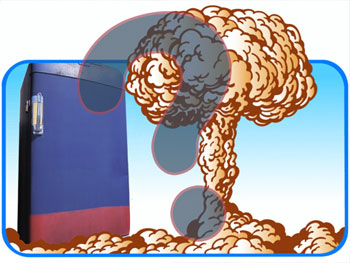
Dr. William F. Brinkman, Director of the Department of Energy's Office of Science, addressed Jefferson Lab staff on the Office of Science perspective during his visit Monday.
One key to movie magic is the suspension of disbelief. Characters jump higher, run faster and survive calamities that challenge the natural laws of science.
Now there’s the "Science of the Movies," a television show that has bad movie science in the crosshairs. Recently, the show took aim at a George Lucas blockbuster, calling upon the assistance of nuclear physicist John Price to help prove a point.
In everyday life, Price teaches at California State University, Dominguez Hills. He also conducts research at Jefferson Lab as part of the CLAS collaboration in Experimental Hall B.
"I study cascade baryons. A cascade is basically a cousin of the proton," says Price, adding that cascades are made of different flavor quarks compared to protons. While the proton has two up quarks and a down quark, a cascade contains an additional type of quark. "I look for events in which two of those quarks are replaced with strange quarks."
Price says producing this different type of particle and studying its properties helps physicists better understand how the proton is made.
"The explanation I usually give people is if you go down to Ikea or Lowe's or Home Depot, someplace like that, and get your proton construction kit, it's got this box with all these parts in it, and the parts are the quarks. And a little instruction manual says how to put it together. A large part of what we're doing at Jefferson Lab is writing that instruction manual," Price explains.
Strangely enough, it was Price's work on the cascade baryons that led to his getting the call from Hollywood.
"It happened because of my association with CLAS and Jefferson Lab. One of my colleagues in CLAS, Jerry Gilfoyle at the University of Richmond, has some connections in Hollywood. They wanted somebody who was a nuclear physicist based in Los Angeles. And he gave them my name," Price recalls.
The host of the show wanted to quiz Price on camera on the veracity of the plotline of an Indiana Jones movie.
"The segment that I'm in is called Bogus Movie Science. The particular scene that we're looking at is in the latest Indiana Jones movie. Early on in this movie, Indy finds himself in this small town in Nevada, populated entirely by mannequins. And then he hears this air-raid siren. And what's going on in the movie is that they are running a test to see what the effects of a nuclear bomb on a small town would be," Price says.

John W. Price
"This bomb is about to go off, and the Russians who are chasing him get out of town as quickly as they can - they drive a car away. But what he did, instead, because he didn't have a car, was he got himself into a refrigerator."
To prepare for the show, Price turned to the Internet. He pulled up a book written by the Department of Defense in the 1950s on the effects of nuclear bombs, watched a few nuclear bomb detonation videos on YouTube and perused the RadWorker I training module on the Jefferson Lab website.
"It's kept me safe since 1985, since I've been working with radiation. The RadWorker I training had all the information I needed," he says.
After the prep work, he and a film crew shot the eight-minute segment on the concrete-covered banks of the L.A. River in California. Over the course of about five hours, Price shared his knowledge.
"There were three people on camera: the host, a guy in the studio and the field geek, and that was me," he says.
Price says the call from "Science of the Movies" was an opportunity to take his role of professor up a notch. "Now my students think I'm cool. I've now gained street cred. I had a blast doing it. And I would do it again."
So what really would have happened had Indy crawled into a refrigerator to escape a nuclear bomb test?
"It's not so much a question of whether he's going to die, but rather, how many different ways he's going to die," Price says.
To find out the details, watch the premiere of the episode "The Explosive Science of "24"" on the Science Channel, airing at 8 a.m. on March 23.
In addition to taking aim at bad movie science, "Science of the Movies" also takes viewers behind the camera for a glimpse of the incredible science that goes on behind the scenes and gives its audience an appreciation for the artistry that goes into creating many of today's best-loved movies.

